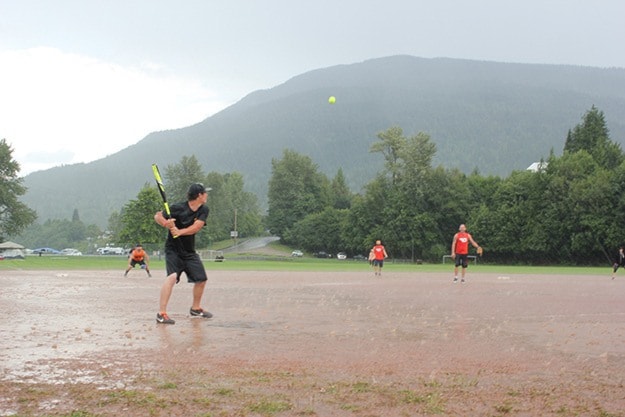Words and photos by Peter Worden
It’s the muddy, boozy, nudity-filled ball tournament Revelstoke’s lucky to have.
This year’s August long-weekend Glacier Challenge slo-pitch tournament brought an estimated 1,500 fun-loving visitors – many diehard returnees –and untold economic spinoff to town. But to think it almost didn’t happen.
In all, 69 teams endured a wet and windy weekend of torrential downpours and hail. The elements mangled tents and made ponds in the infield, and Saturday’s homerun derby asteroided unfortunately situated vehicles and campers. But despite the poor weather and last-minute planning, criticism was minimal and constructive.
“It’s been more positive than I was expecting. I thought I would take a bit of heat this weekend,” said Mark Baron, who co-organized the 29th annual Glacier Challenge for the first time ever with Jen Baron and Maggie Spizzirri. The trio formed earlier this year after no one from last year's volunteer board returned.
 Photo, from left: New organizers Maggie Spizzirri, Mark Baron and Jen Baron.
Photo, from left: New organizers Maggie Spizzirri, Mark Baron and Jen Baron.
What began in 1987 as the Kokanee Glacier Challenge was once a beer company-sponsored mega-event with an all-time high of 144 teams. Since then, it has shrunk by more than half as interest waned and sponsors dried up, leaving organizers scrambling and a proud tournament reeling for some of its former glory.
Long-time slo-pitch tournament-goer Dave Peever of Williams Lake recalls the differences between now and the tournament’s golden years. He has been playing in the Glacier Challenge since 1996 and remembers fans once filled the grandstand (and there was a grandstand), dozens of vendors lined the parking lot and the tournament attracted iconic Canadian musicians such as Trooper, Fleetwood Mac and April Wine. He reminisces about how firefighters would hose down the dusty diamonds along with dozens of players, too, then fill up a pickup truck bed or two while they were at it. But he—and his team—agrees: “It’s still a good time.”
“We definitely get that comment. Everyone thinks it was way better when there were 100-plus teams. But getting back to that isn’t really realistic,” says Jen Baron. “And I don’t think that’s our goal,” adds Mark.
For them, the measure of a well-run ball tournament isn’t its attendance but its character. On that, most players mark the tournament as a success.
“We love this tournament,” said Tyler Orm from Armstrong. Orm has made the trip for 10 years running and other members of his pirate-themed team have been coming for more than 15. The biggest change, he says, is attendance. It was once “elbow-to-elbow” camping. But it’s fun just the same. His team fires a bear banger out of a cannon and they charge the diamond before each game. They lower their team flag to half-mast if they lose and give each team they play a plastic skull and bottle of rum.
Orm says the organizers did a good job by giving teams free wristbands to the beer gardens. His main criticism was playing only one game per day. That, and he wishes future years will see the return of past games like the mud tug-of-war.
 It’s one area Mark Baron says he plans to improve, too. The annual beer-league slo-pitch tournament has traditionally placed a heavy emphasis on the ‘beer’ part. He wants to make it geared more toward families, not just the boozers.
It’s one area Mark Baron says he plans to improve, too. The annual beer-league slo-pitch tournament has traditionally placed a heavy emphasis on the ‘beer’ part. He wants to make it geared more toward families, not just the boozers.
“We’ve heard that for years it’s been a bit of a drunkfest so it gets a bad reputation,” he said. “One of the ways we tried to change the drunkenness of it is by introducing the competitive league and offering up cash. It’s drawing a bit more of a crowd that’s here more to enjoy playing ball and less to get drunk and fall down.”
Also, to mitigate the tournament’s hard-drinking reputation, Jen explains the need to be prudent.
“You prepare by having security and the police on-hand,” she said. “Everyone that we’ve heard from who’s had an interaction with the police over the past few days said that they’ve been nothing but positive. The cops aren’t out to bust people, just keep things in line.”
As she and the board look ahead to future Glacier Challenges, they would like to see money made from the tournament trickle down into maybe a new grandstand or better ball diamonds around the city.
“The town can benefit from the tournament, not just during it, but throughout the year,” says Spizzirri, adding that during the Glacier Challenge’s heyday it would rake in about $1.5 million in local spin off, not including the money raised for the event itself.
For now, the organizers are back to planning next year’s event. Mark Baron says he wants to make the 30th anniversary something spectacular.
“We’ll use it as a chance to start the new generation of this tournament,” he said.

